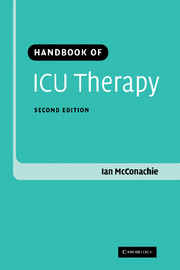Book contents
- Frontmatter
- Contents
- List of contributors
- Preface
- Part I Basic principles
- 1 Cardiac function, monitoring, oxygen transport
- 2 Shock
- 3 Oxygen therapy
- 4 Central venous access
- 5 Fluid therapy in ICU
- 6 Anaemia and blood transfusion
- 7 Nutrition
- 8 Non-invasive mechanical ventilation
- 9 Principles of IPPV
- 10 Modes of ventilation and ventilatory strategies
- 11 Weaning and tracheostomy
- 12 Vasoactive drugs
- 13 Infection and infection control
- 14 Sedation, analgesia and neuromuscular blockade
- 15 Continuous renal replacement therapy
- 16 Withholding and withdrawing therapy in the ICU
- Part II Specific problems
- Index
13 - Infection and infection control
Published online by Cambridge University Press: 24 August 2009
- Frontmatter
- Contents
- List of contributors
- Preface
- Part I Basic principles
- 1 Cardiac function, monitoring, oxygen transport
- 2 Shock
- 3 Oxygen therapy
- 4 Central venous access
- 5 Fluid therapy in ICU
- 6 Anaemia and blood transfusion
- 7 Nutrition
- 8 Non-invasive mechanical ventilation
- 9 Principles of IPPV
- 10 Modes of ventilation and ventilatory strategies
- 11 Weaning and tracheostomy
- 12 Vasoactive drugs
- 13 Infection and infection control
- 14 Sedation, analgesia and neuromuscular blockade
- 15 Continuous renal replacement therapy
- 16 Withholding and withdrawing therapy in the ICU
- Part II Specific problems
- Index
Summary
Infection is a common cause of admission to intensive care units (ICUs). In addition, around 30% of patients in ICUs will acquire infection (nosocomial infection) during their admission. The resulting increase in mortality is between 20 and 80% depending on site of infection and organism. The impact on length of stay and costs is substantial [1]. Increasing severity of illness is inevitably associated with more frequent infections.
Certain causes for admission are more commonly associated with infection:
trauma,
burns,
following emergency surgery (particularly intra-abdominal).
Common intensive care interventions also increase nosocomial infections:
tracheal intubation and ventilation,
intravascular catheters,
urinary catheters,
drugs (sedatives, muscle relaxants, corticosteroids, antibiotics),
blood transfusion.
Some patients are predisposed to infection:
elderly,
malnourished,
high alcohol intake,
heavy smoking,
diabetes,
neutropenia.
The EPIC study
Although 10-year old, the Early Pseudomonas Infection Control (EPIC) study [2] still gives a useful overview of infection in ICUs.
Causative organisms isolated in the EPIC study
Enterobacter 34%.
Staphylococcus aureus 30%, (60% MRSA) — probably now higher, with a greater proportion of MRSA.
Pseudomonas 29%.
Staphylococcus epidemidis 19%.
Candida 17%.
The source of infection is evenly divided between the patients' bacterial flora and exogenous causes.
Site of infection in EPIC study
All lower respiratory tract 65%.
Urinary tract 17%.
Blood 12%.
- Type
- Chapter
- Information
- Handbook of ICU Therapy , pp. 157 - 169Publisher: Cambridge University PressPrint publication year: 2006



